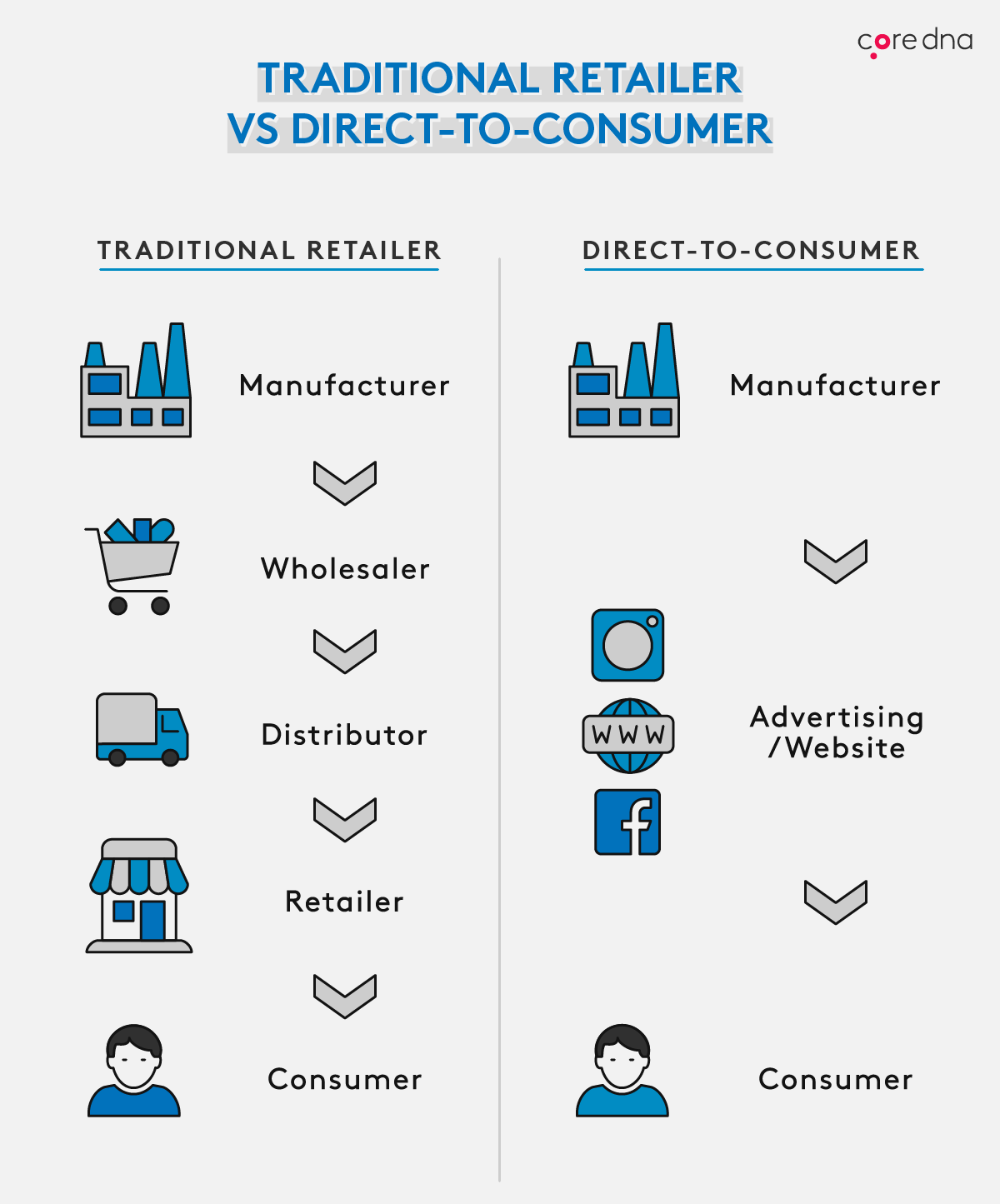Propelled by the rise of digital commerce and media, it’s clear that direct-to-consumer (DTC) is going to represent significant business opportunities for brands. It is no wonder that over a period of 6 years, this rapidly growing market grew from $36.08 billion to a whopping $128.33 billion industry and it shows no signs of stopping.
According to a recent survey, 81% of US consumers plan to shop direct-to-consumer brands in 2023. While this industry continues to grow, the brands that respond fast and include a DTC strategy will significantly profit because they allow themselves and their products to stand out within the marketplace. In addition, they build better and more direct relationships with their customers, which boosts customer loyalty.
In this article, you will get your hands on everything you need to know about direct-to-consumer commerce and marketing. This includes what DTC is, why it is beneficial for your brand, and how your brand can leverage this power to help you build stronger relationships with your target audiences.
What is Direct-to-Consumer?

Direct-to-consumer is a business model where brands connect, deliver services and distribute products directly to their end customers without using any retailers, wholesalers, distributors, and advertisers.
For example, before Nike introduced their own direct-to-consumer strategy it had to sell its products to retailers first. Retailers like JD Sports buy sportswear for a low price, take care of the merchandise, and sell it to the end consumers. Nowadays, Nike can advertise directly on its social media, and its customers can buy products directly from Nike’s official website.
The benefits of direct-to-consumer commerce
Direct-to-consumer gives brands the freedom to connect, engage, and sell to their audience exactly how they want it to. This gives brands that use a DTC strategy in their business model significant control over their services and numerous opportunities and benefits.
Create seamless personalized experiences
Today’s consumers have sky-high expectations around what they need from brands. Most e-commerce experts agree that personalization is the key to attracting and retaining these customers, whether it is via social media, website, or email.
According to a study from Mckinsey, 76% of consumers said that receiving personal communications was a key factor in prompting their consideration for a brand, and 78% of such content made them more likely to repurchase in the future.
Brands that are able to create seamless personalized experiences will help each customer feel more valued at every step of the customer journey. This will drive consumers to be engaged over a longer time and they will recommend the brand more often.
Boost the customer experience
Today’s consumers have sky-high expectations around what they need from brands. Most e-commerce experts agree that personalization is the key to attracting and retaining these customers, whether it is via social media, website, or email.
According to a study from Mckinsey, 76% of consumers said that receiving personal communications was a key factor in prompting their consideration for a brand, and 78% of such content made them more likely to repurchase in the future.
Brands that are able to create seamless personalized experiences will help each customer feel more valued at every step of the customer journey. This will drive consumers to be engaged over a longer time and they will recommend the brand more often.
Boost the customer experience
Did you know that selling isn’t just about the product itself? It’s about the connection the consumer has with their favourite brand and how that brand makes them feel. In fact, 73% of people admit customer experience is an essential factor in their purchasing decisions. DTC allows brands to provide content directly throughout the entire customer journey, so they can create an excellent customer experience exactly as they envision it should be.
The Importance of Data Collection in DTC commerce
When it comes to customer segmentation, shopping trends, and overall understanding of the customer base, data collection is vital. 60% of companies around the world already use data and analytics to drive process and cost-efficiency.
The introduction of headless commerce has leveraged this power even more because more brands can use independent CRM tools for their data collection. With CRM tools, DTC brands can collect valuable data from each transaction, including customer trends, shopping patterns, demographics, and other insights.
Brands use this data to tweak their approach to marketing and advertising to their customers and the benefits are numerous. This goes a long way toward improving your ROI, shortening your sales cycle, and making the kind of expansion you’ve always dreamed of a reality.
Increase revenue
As discussed earlier, DTC helps you build meaningful relationships with your audience, it helps you deliver an irresistible customer experience, and it also gives brands the power to personalize their complete customer journey.
However, did you know that it can be equally valuable for maximizing a brand’s sales and revenue? In fact, according to a survey described in Modern Retail Research, 54% of the DTC respondents said they saw an increase in direct retail revenue.
A brand that implements DTC in its strategy is able to create a high level of customer loyalty and loyal customers spend more than newly acquired customers. For example, Nike’s revenue grew over the last six years by around 46%. While their wholesale sales stayed the same at around 25 billion, their direct-to-consumer sales grew at least 200%.
DTC strategies and examples
The first thing you need to know about DTC commerce strategies is this. There is no one-size-fits-all DTC strategy because every brand has different goals and targets different audiences. However, most businesses use one or a combination of the following strategies to maximize both outreach and sales. To find out what DTC strategies work best for your business, use the following strategies and examples as a guide.
1. Social media marketing
When you have a large social media following, you have endless DTC opportunities since you can communicate directly with this audience. In order to use social media marketing in your DTC strategy, you must create and publish unique content consistently. By creating valuable content combined with the latest social media trends, you are able to reach a wider audience to engage with your brand.
For example, Glossier is a direct-to-consumer cosmetics brand that sells skincare, makeup, fragrances, and other products. After they emerged with the beauty blog ‘Into the Gloss‘, Glossier founder Emily Weiss started selling products directly to consumers in 2014. She managed to leverage the power of social media channels and connect with their target audience.
As a result, Glossier generated an incredible 600% year-on-year growth from 2015 to 2016 after launching in late 2014. Today Glossier is one of the most recognizable cosmetics brands in the United States.

2. Personalized emails
Did you know that Automated emails enhance the personalization of your DTC strategy? For example, you can personalize the subject line or the body and by personalizing your emails, your conversions can shoot up by 10% and click-through rates by 14%.
If you want to take personalization a step further, then email marketing automation software is a must-have. For example, ActiveCampaign helps you create personalized email marketing funnels where consumers follow certain paths when specific actions are taken by the customer. This approach is much more effective because these timely emails are sent in response to a shopper’s actions.
When it comes to building and growing your email marketing list, you will need a lot of time and resources, which is why partnering with a team of experts can be beneficial. When done properly, your business will highly benefit from it:
- Your email marketing strategy boosts your overall revenue between 20% to 30%.
- Email marketing has an impressive ROI of $36 for every $1 spent.
- 99% of email users check their inbox every day, with some checking 20 times a day.
3. Influencer marketing
Influencer marketing enables direct-to-consumer businesses to leverage the existing reputation of an influencer. With more and more noise on social media, consumers are nowadays extremely skeptical about paid marketing campaigns. As a result, 61% of consumers trust influencers’ recommendations more than the 38% who trust branded (and often biased) social media content.
One of the brands that have leveraged the power of influencer marketing the most is Gymshark. With over 3.8 million followers on TikTok alone, it’s clear that they’re getting it right with their DTC social media advertising strategy.

4. Custom products
Despite the fact that some direct-to-consumer brands only sell ready-made products, custom products can often meet the preferences of each customer. With more customers looking for personalized items, there’s a growing market for custom-made products of all kinds.
Customization of products means that customers can select features like colour, design, functionalities, add-on components, or other options to make a more unique item rather than a mass-produced one. For example, Vans allows their customers to design and order one-of-a-kind sneakers through their online platform.
5. Social activism
Brands that think they can attract their audience with low prices and a positive customer experience are wrong because there is among consumers a growing trend toward corporate responsibility. In fact, 74% of consumers aged 22 to 37 believe that brands should take public positions on social values.
One of the best examples of social activism today is Warby Parkes. They are famous for their “buy a pair, give a pair” initiative. Every time someone buys a pair of Warby Parker glasses, another pair is donated to a person in need.
Is your business ready for the future?
With more consumers demanding higher expectations from their favourite brands, there’s never been a better time for brands to consider investing in DTC. It provides everything brands need to allow themselves and their products to stand out within the marketplace. In addition, they build better and more direct relationships with their customers – both online and offline – which results in building loyalty and raising their revenue.
It is critical to know that creating and implementing a DTC strategy is a long-term strategy that takes time to develop. If you find yourself in a situation where you want to implement direct-to-consumer in your business but you or your business isn’t ready yet, partner with a team of brand and design experts who will guide you through the complete process, this will help you save unnecessary costs and dozens of hours you can spend on your talents.
Get in touch with our team today and experience how we can help you create a digital transformation within your business.




